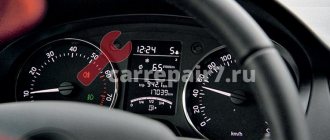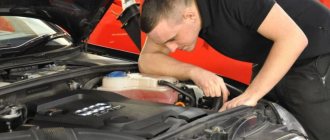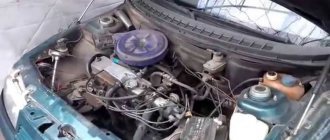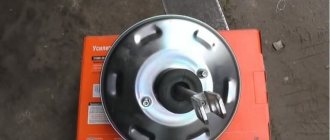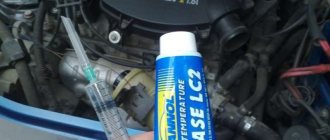Most car enthusiasts are faced with the problem of engine jolts during smooth or sudden acceleration. This problem is not critical and can be easily repaired. Moreover, users of both domestic VAZ 2112 with a 16-cl unit and owners of foreign cars such as Hyundai Solaris are not insured against this. If the car jerks when you press the gas pedal, you need to investigate such units.
- Fuel supply. As a rule, problems with acceleration begin after refueling at a questionable gas station.
- Air in the system. Excess oxygen may also leak through cracks or leaky clamps.
- Ignition. This topic is worthy of a separate issue.
- Pressure lines. Fuel pumps, ramps, injectors, filter inserts are units that require increased attention.
So, you need to figure out what to do when the car starts to jerk during acceleration.
The reason for the car “jerking” when you press the gas pedal
There are several obvious causes of jerking and increased vibration of the car during driving and acceleration. The exact diagnosis and cost of fixing the problem depends on the specific case and its neglect.
Car jerking due to TPS
The throttle position sensor is a pressing problem in modern engines with high mileage. Sensitive electronics may transmit incorrect data to the ECU or fail completely. Additionally, the valve may become clogged. Troubleshooting occurs by cleaning the remote control and diagnosing the sensor. The sensor is replaced with a known good one.
Car jerking due to mass air flow sensor
A similar problem occurs when the mass air flow sensor fails. The device is located behind the filter or in front of the throttle. The sensor is responsible for reading the amount of air consumed and transmitting the impulse to the electronic control unit.
If the system is damaged or worn out, an incorrect signal is transmitted to the head electronics - the indicators jump. Consequently, the “brains” of the car try to balance the speed of the power plant, constantly adjusting the fuel supply. As a result, this leads to the car jerking.
The problem can be fixed simply - the damaged sensor is replaced and errors are reset to the computer.
Car jerking - malfunction in the carburetor chamber and pump
A pressing problem for classic engines. The outdated design of carburetors is sensitive to low-quality fuel. Dirt and debris entering the system can disrupt the operation of the jets and float chamber. To repair the unit, it is enough to rinse it with clean fuel and blow out the passage channels with compressed air.
In classic engines, the problem of overheating of the fuel pump is not uncommon. In particular, the problem often appears on VAZ 2101-07 models. The original pump can heat up, which causes the formation of gas bubbles and interferes with the normal flow of fuel. Motorists change pumps and install structures of a different type instead.
Engine jerking due to problems with the ignition system
Improper ignition operation can cause the car to malfunction. In 90% of cases, the cause is the failure of the spark plugs to produce a spark. The bottom line is this: the fuel in the chamber does not burn as expected. Power drops and problems with the stability of the power plant appear. When the ignition in a car malfunctions, a clear symptom is engine trouble. The failure of one or more cylinders makes the entire installation tremble.
The problem is easily removed. Starting from the spark plugs, you should check the line and find the failed element.
Malfunction of fuel system sensors
Sensors for fuel consumption, pressure inside the line, fuel remaining in the gas tank, and throttle position, together or individually, can disrupt the stability of engine operation.
If the cause cannot be found, perhaps the root of the breakdown is located here.
Problems in the fuel supply system
On modern cars, failures caused by clogged injectors are a common problem. Due to low-quality fuel or faulty filters, dirt can clog thin pressure lines and bypass valves. A similar problem occurs in diesel engines.
To diagnose and eliminate car jerking, you should contact a qualified technician. It is strictly not recommended to “climb” into the fuel rail or injectors without sufficient experience.
Malfunction in the mixture preparation unit
The stability of the machine is also affected by the correct operation of the mixture preparation chamber. If the device is not calibrated correctly, the engine speed jumps, the car jerks.
The source of the problem can be eliminated by reconfiguring the system and periodically cleaning it.
We are looking for an electrical reason
This “headache” is relevant for most motorists who own outdated foreign cars with high mileage. Outdated car brains often become unstable, work intermittently, and can generate incorrect signals to control equipment.
Control units can disrupt the stability of the ignition system, fuel and air supply.
Poor quality fuel
Gasoline is the “food” for a car. If bad fuel is used, the vehicle will not be able to operate properly. If the car jerks noticeably when you step on the gas, you need to remember what kind of fuel was filled and at what gas station. The problem arises due to low-quality gasoline, or the fuel does not have the correct octane number, so a normal mixture cannot be formed.
Attention! It is not recommended to drive with such fuel; the fuel system may become clogged.
To check, you need to drain the fuel, flush the system, and add new gasoline at another gas station. If the problem goes away, you need to drive around the ill-fated gas station; if not, you should look for the cause.
Causes of overclocking failure
The next common problem with some engines is poor acceleration. The problem is relevant regardless of the type of internal combustion engine and the type of fuel consumed. What makes the situation easier is that motors that differ in design have their own unique and common disadvantages. Similar traits can be described together.
- The spark plugs do not fire correctly or the high-voltage wires are broken. To eliminate the failure, you need to check everything, right down to the coils. If the nodes are working normally, you need to move on.
- Filters are clogged. A common problem for all engines is clogging of the fuel supply and air lines. Obstacles may cause problems with dynamics.
- The ignition is set incorrectly - this can also cause jerks during acceleration.
Injector
Node problems:
- Decrease in fuel pump efficiency. Similar to the principle of diesel engines, gasoline is pumped into the ramp by an injection pump. If the performance of the device is not enough, a negative effect appears.
- The injectors are clogged. Fuel nozzles have a small outlet. If even a grain of sand gets in, the throughput is sharply reduced. As a consequence, the ensuing trouble.
- Problems with MRV and PDZ sensors. Worn out or damaged sensors transmit information to the “brains” late or completely incorrectly.
- ECU. The presence of errors or software glitches inside the device provokes such breakdowns.
Carburetor
It's a little easier with a knot.
- Damage inside the float chamber. A common cause is incorrect float setting. The chamber is responsible for maintaining a minimum fuel reserve for rapid acceleration. If its regulator is set incorrectly, the capacity is not fully filled and a failure occurs during acceleration.
- Throttle cable stretch. Some classic owners have a slightly loose gas pedal, therefore the response from the carburetor will not be quick.
- The fuel pump is not working. Low efficiency of the pump or its wear also directly affects the dynamics of the car.
Diesel
- The injection pump is damaged or clogged. Conventional diagnostics of the node helps correct the situation.
- The injectors are worn out or clogged. The problem is eliminated by diagnostics on the stand.
The car jerks on the gas
It happens that a car with installed HBO jerks at idle or during acceleration. At the same time, car enthusiasts often look towards gas. However, the problem is not always hidden here.
Idling
Gases have slightly different combustion parameters and working mixture proportions. In some cases, it is enough to calibrate the mixer and everything will fall into place.
The problem is not with HBO
In most cases, when pulling a car, HBO is not relevant. Problems encountered on a conventional carburetor or injector are relevant here.
Note! According to statistics, in 8 out of 10 cases the gas installation has nothing to do with the problem.
The problem is in HBO
If the reason lies in the gas installation, it should be looked for in air sucking into the system.
- At connecting pipes or highway joints. To find the problem, just treat all “suspicious” areas with a soap solution and see where the bubbles swell.
- Damage to the hoses themselves. Hoses can crack due to time and constant overheating.
- Suction through the installation site of the fitting (cotton). Here it is enough to tighten the connection.
- Cracking of the gearbox gasket. The part is often exposed to critical temperature changes, which can lead to its failure.
Engine jerking due to problems with the ignition system
If, when the car picks up speed, you observe sharp drops in power, then the reason lies in malfunctions of the ignition system elements. This problem applies to any type of engine. The only correct solution is to check the ignition with the engine turned off. It is carried out by the following signs:
- The tightness of the pads with the wires is checked;
- No chips and good condition of the reel;
- The wiring connecting the ignition system to the engine is in good condition.
After checking all the elements, you need to start the car and just listen to how the engine began to work. If you notice the appearance of characteristic clicks, it means that there are small breakdowns in the system with high voltage. In this case, you will have to buy all the elements of the ignition system - a coil, a block and a set of high-voltage wires.
Tip: Do not try to replace the wiring on your car yourself. Only highly qualified specialists can, using instructions and diagrams, correctly connect relays and fuses, after which the ignition system will not burn out. You can also check the wheels at the same time by checking the car tire pressure table.
If the engine runs smoothly, the problem may lie in the spark plugs. And to put it more precisely - in the absence or rare appearance of a spark. The presence of defects in the spark generation system can be easily detected if the car engine starts to run jerkily when descending from hills and even on flat sections of the road.
For example, a problem with a set of spark plugs is typical for vehicles under the Nissan brand. This is due to the equipping of their SA-18 model engine with a special non-contact distributor design. The distributor housing contains a switch, if it malfunctions, the spark signal does not arrive at the on-board computer, and such a specific movement of the machine occurs. Motor jerking can be corrected only by completely replacing the distributor components.
If the set of spark plugs is in excellent condition, the only remaining cause may be a malfunction in the operation of the carburetor-type engine control unit. In this case, jerks do not occur constantly, but randomly and only during a long drive of the car.
It is possible to detect faults in the control unit only after diagnostics in a car service center on a special stand. Also, with the help of a lift, you will be able to see that the car twitches occasionally when idling. As a result, the control unit (EFI) should be replaced along with faults found in other components of the vehicle.
car pads
Diagnostics
The diagnostic procedure for different engine designs is performed according to a different algorithm.
However, there are general faults. During the process, it is necessary to check the fuel system, air supply lines, and ignition apparatus. In this case, troubleshooting is performed one by one for all units. If the sequence gives a result, the damaged node is replaced with a known good one (new).
Mix preparation unit
Depending on the type of engine, the injector or carburetor is responsible for preparing the mixture. Mechanisms can cause jerking when driving. In the injector, the malfunction is caused by clogged air channels or nozzles, in the carburetor - by the jets.
The units become clogged after refueling with low-quality fuel, when the car has been standing idle for a long time.
To fix the problem, cleaning is required. In the case of a carburetor, you can do the procedure yourself even on the road. Under the hood you need to remove the air filter to gain access to the carburetor. It is necessary to blow out the channels with a pump. It is more convenient to use a compressor; a regular hand or foot compressor will do.
The effect of the procedure does not last long; in emergency cases, this is the only option to get to a service station. It is recommended to completely flush the carburetor with appropriate products. If you have no experience in carrying out such actions, it is better to trust the professionals in the car service.
In the case of an injector, you won’t be able to flush the system yourself; to do this, you need to imitate the operation of the engine, and special equipment is required. You'll have to go to a car service center.
Many people wash the injectors, and the problem goes away for some period. This effect will not last long, the parts will become clogged with dirt again. You need to purchase new injectors and install them to replace the old ones.
What to do
If you lack knowledge or lack confidence in your own abilities, you can seek help from a service station, where specialists will conduct a diagnostic examination and repair the car.
If the user decides to figure it out on his own, he must do the following.
When I press on the gas, the car jerks and does not move.
In the case when the car behaves predictably at idle, and when the trigger is pressed, jerks are felt, and the car slowly picks up speed. The problem lies in the lean or over-enriched mixture entering the cylinders. It doesn’t matter whether it’s an old VAZ or a new modification like the Hyundai Accent. The original source is located here.
The secondary question is how this happens, because in 50% of cases the carburetor or injector is configured correctly.
The car jerks when accelerating and pressing the gas sharply
Similar symptoms occur on fuel-injected foreign cars - when the trigger is pressed firmly, the car jerks. In this case, acceleration occurs in normal mode. For cars such as Ford Focus, Opel Astra J, Chevrolet Cruze, the problem may be a breakdown of the ECU, mass air flow sensor, or TPS. The problem also does not avoid modifications of the VAZ 2114 and Audi A6 C5. The easiest way to diagnose is to replace parts with obviously new ones. Thus, the throttle position sensor may become “stupid”, incorrectly indicating to the ECU the location of this unit, which causes variable throttle opening with all the ensuing consequences. Also, the mass air flow sensor may incorrectly interpret the indicators, which will cause the mixture to become leaner.
When you press the gas pedal, the car stalls, then jerks sharply
When a vehicle stalls during acceleration, followed by a sharp jerk, and then the dynamics stabilize. The following items need to be checked:
- air line;
- accelerator pump;
- fuel quality;
- checkpoint;
- main fuel pump;
- ignition settings;
- MRV sensor.
Owners of the Lada Priora periodically face the problem of fuel pump failure. Here it will be enough to replace the element with a new one, to be on the safe side, clean the lines (low-quality fuel could get in).
Also, in some cases, the engine begins to stall and then accelerate. Here, the mass air flow sensor is checked, the spark plugs are diagnosed, the ignition angle is checked, and the injectors are clogged.
Additionally, if you have an automatic transmission, you need to check this mechanism. About 20% of visits to a car service center with similar faults end in “treating a surprise” inside the torque converter.
The car jerks while driving when the gas pedal is pressed lightly
A more exotic malfunction is when, when you smoothly press the trigger, the car begins to twitch until the power plant reaches a certain speed. There is a lack of combustible mixture in the float chamber of the internal combustion engine - gasoline burns faster than it can flow. This is a side effect of a faulty fuel pump; the unit does not have time to pump a new portion of the mixture, which provokes engine jolts.
Note! On independent designs like the carburetor Oka or the injection Lanos, the breakdown in 90% of cases manifests itself in the same way, which narrows the search area.
The car jerks when you press and release the gas
If, when the speed is reduced, the car begins to nod, and during acceleration it jerks again, there may be two sources of the problem.
- Sensor failure. Faulty sensors send incorrect data to the ECU, causing a disruption in the uninterrupted fuel supply.
- Clogged dosing elements (nozzles, jets). Owners of classic models such as the VAZ 2107 often encounter a similar problem. A clogged injector, after releasing the gas, “spits out” part of the fuel, which causes an increase in speed. During sudden acceleration, the element does not have time to supply the required amount of mixture to the cylinder.
Carburetor car jerks when you press the gas
If a problem is detected on carburetor vehicles such as VAZ 2109/2106. First of all, you need to pay attention to the fuel supply system . The design of standard Solex carburetors has outlet tubes designed to supply gasoline to the mixture formation chamber. By pouring low-grade fuel, thin channels can become clogged, which prevents its free passage. Usually the channel of the first chamber is clogged. If the engine jerks while gaining speed, and after reaching 2500-3000 rpm the acceleration proceeds smoothly - this is where the trouble lies.
The defect is eliminated by purging the unit with compressed air and preliminary cleaning the jets (just in case).
It is also necessary to check the main pump (a problem with all classics), and the ignition timing.
When you press the gas, a car with an injection engine jerks
If the injection VAZ 2110 twitches, the search for the problem should start from the MVR, PDZ, and ECU sensors.
In this case, faulty sensors can send a false signal to the control unit, which is the primary source of the trouble. The next reason is clogged injectors. Symptoms usually appear 15-20 km after filling low-quality fuel into an empty tank.
The last point is failure, ignition interruptions. Spark plugs and armored wires are diagnosed.
Diesel car jerks when pressing gas
Regarding diesel engines, the solution to the problem is extremely simple - jamming of the moving blades of the main pump. The reason for this phenomenon is considered to be long-term downtime of transport in a damp place. It is moisture that oxidizes metal surfaces, which leads to jamming of the structure.
Failure repair is carried out by replacing the damaged part.
Malfunctions in the carburetor chamber and pump
If a car with a carburetor jerks when you press the gas, you need to check the chamber.
The outlets often become clogged. The fuel enters the engine with contaminants, the mixture is bad, and the engine cannot operate normally. To eliminate the problem, it is enough to clean the pipes with compressed air, initially dismantling the carburetor.
Sometimes the accelerator pump becomes unusable. Not all the mixture enters the engine, the power unit is “starving”, unstable, and operates jerkily. The pump can be accidentally damaged during repairs due to the inconvenient location of the device. The part is useless to repair; you should purchase a new one.
Carburetor chamber diagram
Engine control unit calibration
The engine control unit is an important component for the proper operation of the power unit. The parameters in the firmware may have gone wrong due to an error when connecting the equipment or for other reasons.
You should try restarting the software. If the problem is not solved, the electronic control unit will need to be reflashed. It is not recommended to do anything with the “brains” of the car unless you have special equipment and skills. Incorrect actions can lead to damage.
Drop in injector speed
The characteristic “thoughtfulness” when vigorously pressing the gas pedal indicates incorrect operation of the injectors or fuel pump. You can check whether the quality and volume of the mixture your car “feeds” corresponds to the standard through detailed diagnostics. Separately, you need to remove the injectors and check their performance on a bench.
It is easier to look for the cause in a sequence from simple to complex: change the fuel, flush the tank, replace the filters, check the pump mesh in the tank and the pressure in the rail, then test the injectors.
Some injectors can be restored, others will have to be replaced, correctly registering the replacement in the “brains”. Difficulties during acceleration can also be a sign of a malfunction of the electronic unit that controls the injection system. If it cannot be eliminated by chipping, the “brains” will have to be changed.
Faulty injectors
Regardless of what kind of engine you have (gasoline or diesel), it has injectors installed for fuel injection (except for carburetor options). They regulate the injection of a measured dose of fuel into the combustion chambers. Clogging or wear of the working part causes an injection failure (little or too much fuel), which causes an interruption in the operation of the engine as it accelerates, twitching, or “trippling.”
A malfunctioning throttle valve also interferes with acceleration; the engine begins to twitch during acceleration due to lack of air. It is also worth checking for functionality and serviceability of the sensor installed on it.
